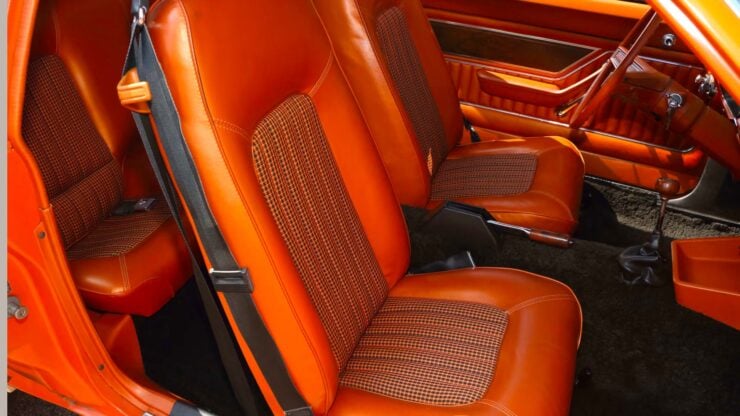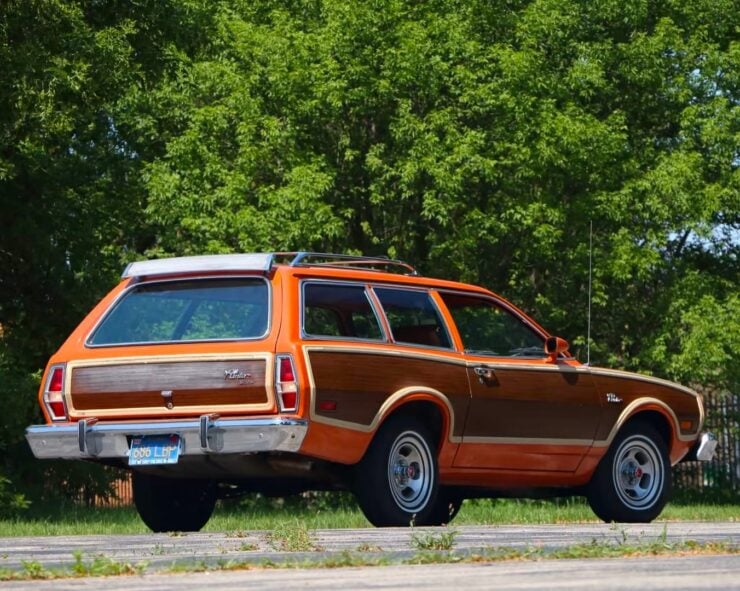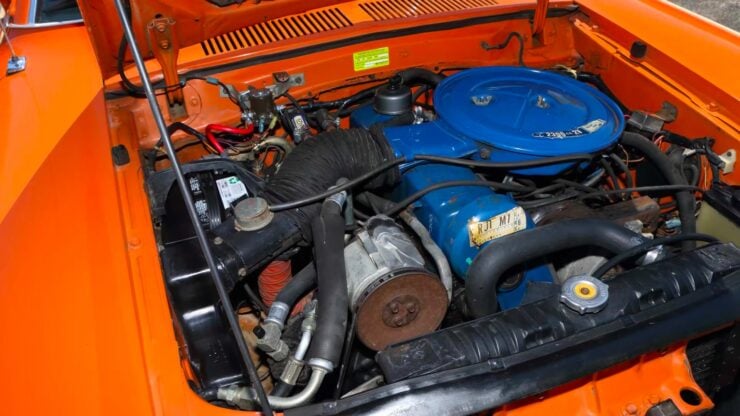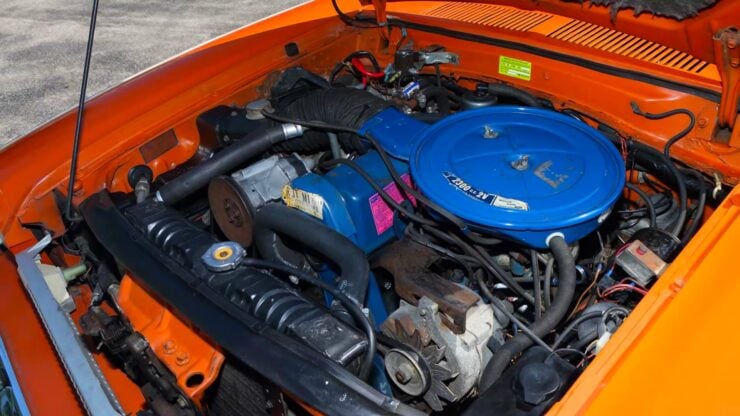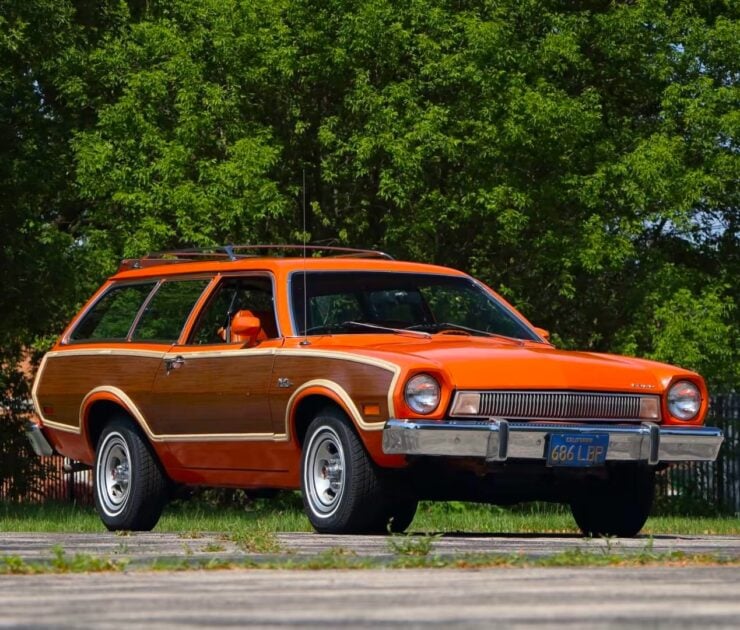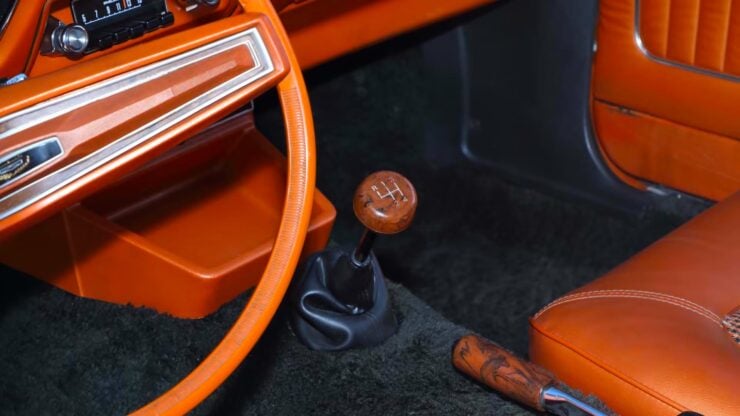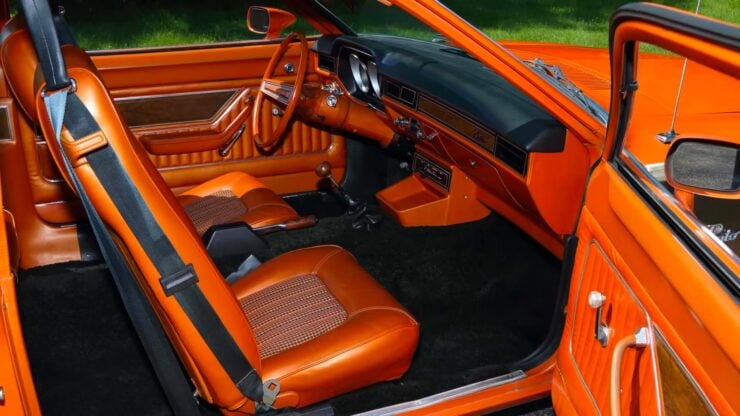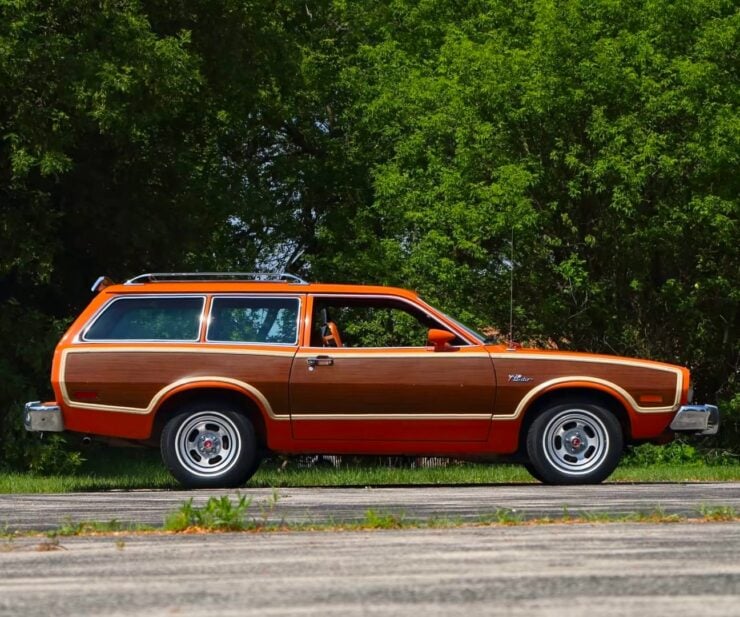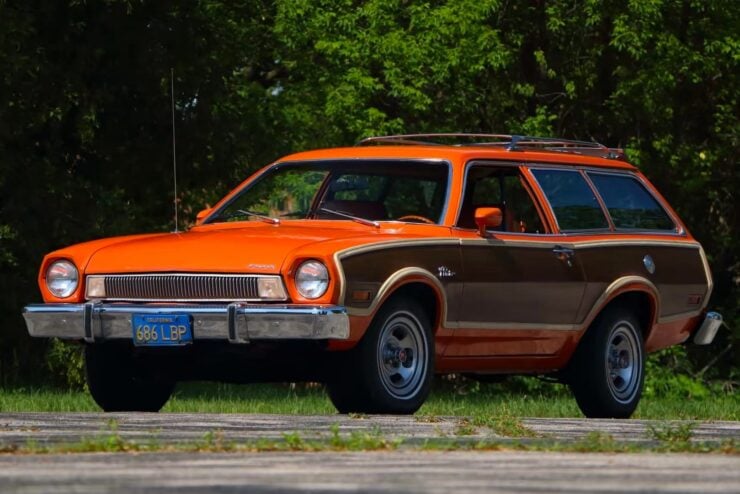This 1974 Ford Pinto Squire Wagon is a remarkable survivor, presenting in time-capsule-like condition, and showing just 39,437 miles on the odometer.
This car is powered by the optional 2.3 liter inline 4-cylinder engine mated to a 4-speed manual gearbox, and it came with factory air conditioning, a factory Philco AM radio, an Orange exterior with simulated woodgrain paneling, and an interior with Orange Houndstooth bucket seats.
Fast Facts: A 1974 Ford Pinto Squire Wagon
- The Ford Pinto was developed rapidly in the late 1960s as a direct domestic competitor to imported subcompacts. Ford’s goal was a lightweight, affordable vehicle priced under $2,000. Engineering began in 1968 and the car was on sale by late 1970, which required a shortened development cycle that led to long-term safety concerns.
- The Pinto sold strongly throughout the 1970s, with peak sales in 1973 and 1974 due in part to the Oil Crisis. Initially offered with 1.6 liter and 2.0 liter engines, later variants included a 2.3 liter inline-four and a 2.8 liter V6. Body styles included sedan, hatchback, and wagon, the latter arriving in 1972 and proving popular with families.
- Safety controversy arose from the rear-mounted fuel tank in sedans and hatchbacks, which was prone to rupturing and catching fire in rear-end collisions. Public outrage intensified after a 1977 Mother Jones article. Ford eventually recalled 1.5 million vehicles and was acquitted in a criminal trial, but the damage to its public image was lasting.
- The featured 1974 Pinto Squire Wagon has just 39,437 miles and retains original details like paint, trim, and interior. It includes the 2.3 liter engine, 4-speed manual, air conditioning, and a period “Geraghty Super Tune” for some additional power. It will be auctioned by Mecum with no reserve in July.
The Ford Pinto
The Ford Pinto was born out of necessity. In the late 1960s, American automakers were watching compact imports steadily chip away at domestic market share. Cars like the Volkswagen Beetle, Toyota Corolla, and Datsun 510 were inexpensive, efficient, and perhaps most crucially, better suited to short-hop urban American driving.
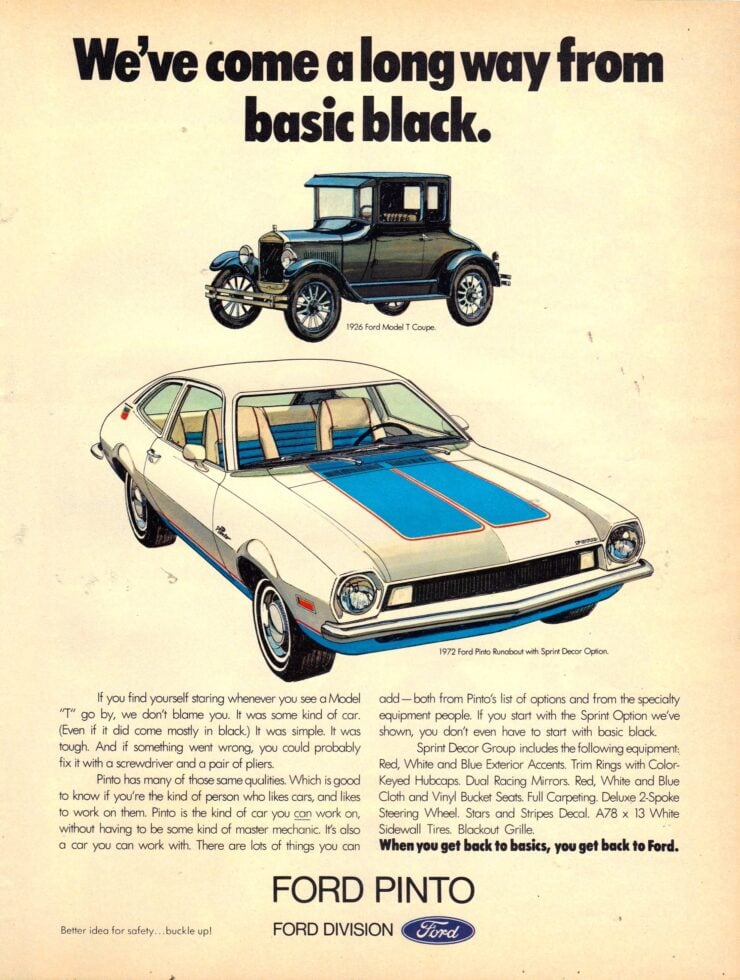

Ford needed a direct competitor to these subcompacts, and quickly. Lee Iacocca, then a key executive at Ford, championed a new strategy for the Blue Oval to develop a domestic subcompact from scratch, with a tight two year timeline, a target price under $2,000, and a target weight of under 2,000 lbs.
The Lighting-Fast Development Of The Pinto
The Pinto was a major departure from Ford’s usual development cycle in which most cars of the era took roughly 43 months from approval to reach production – the Pinto’s proposed rapid timeline demanded corners be cut left and right, and this would result in issues that would ultimately prove fatal.
The Pinto was designed in record time – engineering started in December 1968, and by September 1970, production was underway at Ford’s Edison, New Jersey, and Richmond, California plants. The official launch came on September 11, 1970, as a 1971 model.
Ford positioned the Pinto as an affordable, American-built alternative to subcompact imports. It featured unibody construction, a front mounted engine sending power to the rear wheels, rack-and-pinion steering, and coil-spring suspension up front with a live rear axle on leaf springs in the back – all pretty standard for the time.
At launch, it came as a two-door sedan, with hatchback (Runabout) coming a little later, and a two-door station wagon variant arriving in 1972.
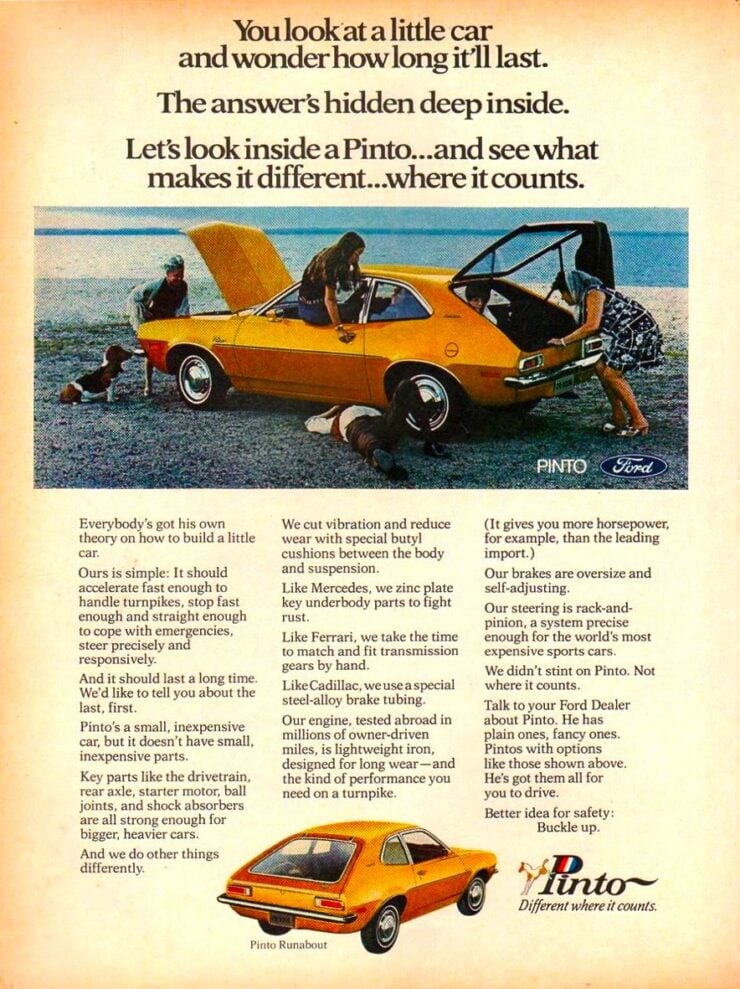


Pinto Specifications
Customers could choose between two inline-four cylinder engines: a 1.6 liter Kent unit sourced from Ford of Europe, or a 2.0 liter OHC engine built in the US. Initially, the Pinto offered a 4-speed manual transmission, with a 3-speed automatic as an option. Over its production life, engine options expanded to include a 2.3 liter “Lima” engine and a 2.8 liter Cologne V6 – popular for wagons and sporting variants like the Pinto Cruising Wagon and the Pinto Stallion.
The Pinto was a major sales success right from the get-go – Ford sold over 352,000 units in its first year, almost half a million annually in 1972 and 1973, then over half a million in 1974. In total, over three million were sold during its 10 year production run.
The Pinto’s small size, simple engineering, and competitive pricing made it a popular choice even before the 1973 Oil Crisis struck – and caused fuel prices to skyrocket in the USA and around the world. This was a key reason that the Pinto’s two best sales years were 1973 and 1974.
The Pinto was particularly appealing to younger buyers with lower budgets, as well as small families, and it served as the basis for Mercury’s slightly more upmarket twin model, the Bobcat.
The Infamous Pinto Controversy
The Pinto’s reputation would soon become overshadowed by controversy – most infamously, its fuel tank design. Beginning in the mid-1970s, reports emerged of Pintos catching fire after rear-end collisions.
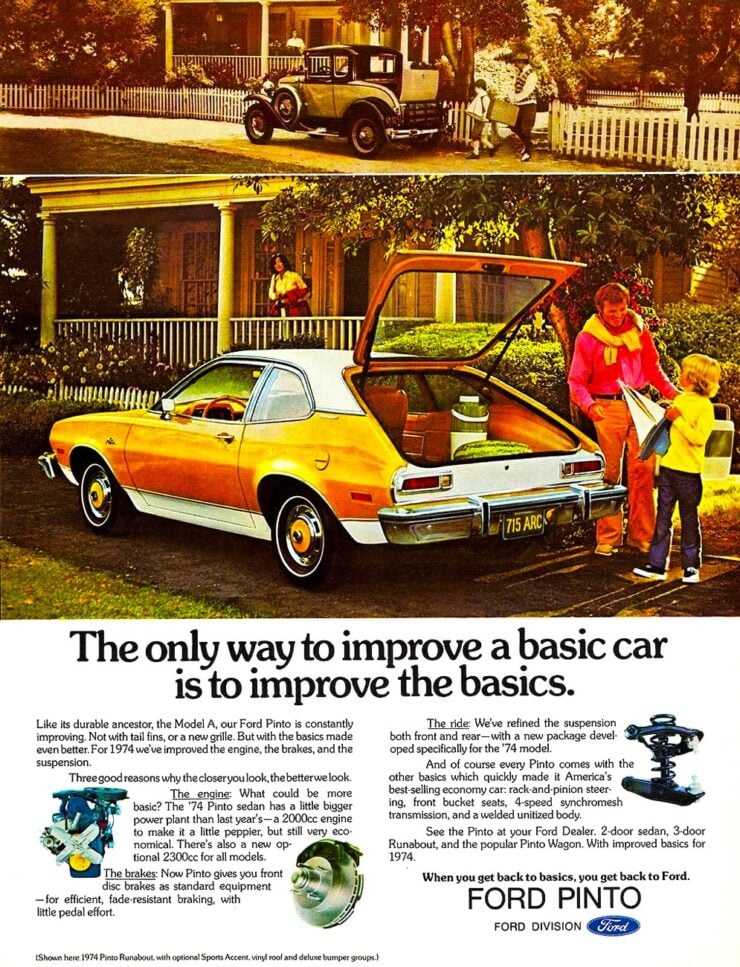


The issue stemmed from the placement of the gas tank just behind the rear axle. In certain impacts, the filler neck could tear away, and bolts on the rear differential could puncture the tank, leading to fuel leakage and catastrophic fires.
An exposé by Mother Jones in 1977 intensified scrutiny – it alleged that Ford had conducted a cost-benefit analysis, weighing the expense of retrofitting vehicles with safer tank designs, estimated at $11 per car, against potential legal settlements for burn injuries or fatalities.
The report claimed that Ford chose to forgo the fix. Although the article’s calculations and interpretations were later contested and many were proven false, public perception was already cemented. The Pinto became shorthand for corporate negligence.
The controversy triggered lawsuits and a federal investigation. In 1978, the National Highway Traffic Safety Administration (NHTSA) ordered Ford to recall 1.5 million Pintos – the largest automotive recall at the time – for a retrofit kit that added a plastic shield to protect the gas tank.
Ford also faced a landmark criminal case in Indiana over the deaths of three teenage girls in a Pinto crash. The company was acquitted, but the trial marked the first time a US corporation was indicted on criminal homicide charges stemming from a vehicle defect.
Throughout the storm, Ford continued to sell the Pinto until 1980, when it was replaced by the front-wheel-drive Escort. While Ford initially stood by the Pinto, the company later admitted its handling of the fuel tank issue had damaged public trust.



In retrospect, the Pinto is both a product of its time and a cautionary tale – it was built fast to meet a demand, priced to compete, and successful on the sales floor. But in cutting corners and misjudging public reaction to the ensuring controversy, Ford underestimated how reputation damage can outlast sales and initial profitability.
For better or worse, the Pinto left its mark – not just on American driveways, but on the entire auto industry’s approach to safety and corporate ethics. People today often forget that the car was actually a huge success from a sales perspective, particularly in the first half of its decade-long production run, and it formed the basis of Ford’s subcompact model lines that would follow.
The 1974 Ford Pinto Squire Wagon Shown Here
The 1974 Ford Pinto Squire Wagon is a rare survivor from the peak of Pinto popularity, and as its the station wagon version its apparently not susceptible to the same rear-end collision/fuel tank fire issue as the sedan or hatchback.
There’s no way to describe this car without mentioning at least once that it’s very much a product of the 1970s. The bright orange paintwork, the faux wood trim down the sides, the Orange Houndstooth bucket seat interior, the whole ensemble would have been considered very fashionable in 1974.
This car was ordered with a few optional upgrades including the more powerful 2.3 liter engine, factory air conditioning, a factory Philco AM radio, and a factory rear defogger. It was also ordered with the 4-speed manual transmission, a much more sporting choice than the optional 3-speed automatic.
Interestingly, this Pinto was “super tuned” using vintage Geraghty Super Tune specs from Car & Driver magazine – this involved re-curving the distributor, re-jetting the carburetor and performing other tweaks to the emissions-era 2300 engine to boost power.
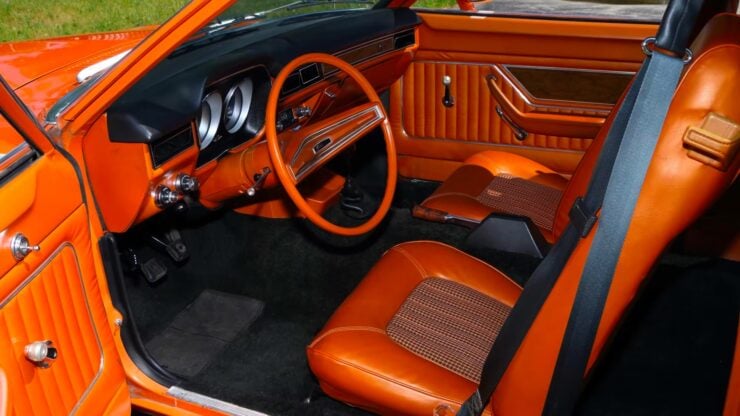


The vehicle still has its original paper tags, ink stamps, and factory markings throughout engine compartment and chassis. More recently it was fitted with new brake hydraulics, gas shock absorbers, whitewall radial tires, and all ethanol-safe fuel system components.
It’s now due to roll across the auction block with Mecum in late July and it’s being offered with no reserve. If you’d like to read more about it or register to bid you can visit the listing here.
Images courtesy of Mecum


